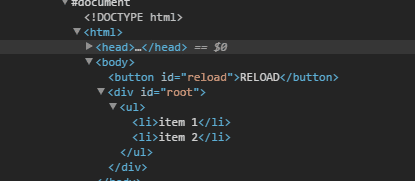如何编写自己的虚拟DOM?方法介绍

要构建自己的虚拟DOM,需要知道两件事。你甚至不需要深入 React 的源代码或者深入任何其他虚拟DOM实现的源代码,因为它们是如此庞大和复杂——但实际上,虚拟DOM的主要部分只需不到50行代码。
有两个概念:
- Virtual DOM 是真实DOM的映射
- 当虚拟 DOM 树中的某些节点改变时,会得到一个新的虚拟树。算法对这两棵树(新树和旧树)进行比较,找出差异,然后只需要在真实的 DOM 上做出相应的改变。
用JS对象模拟DOM树
首先,我们需要以某种方式将 DOM 树存储在内存中。可以使用普通的 JS 对象来做。假设我们有这样一棵树:
<ul class=”list”> <li>item 1</li> <li>item 2</li> </ul>
看起来很简单,对吧? 如何用JS对象来表示呢?
{ type: ‘ul’, props: { ‘class’: ‘list’ }, children: [
{ type: ‘li’, props: {}, children: [‘item 1’] },
{ type: ‘li’, props: {}, children: [‘item 2’] }
] }这里有两件事需要注意:
- 用如下对象表示DOM元素
{ type: ‘…’, props: { … }, children: [ … ] }- 用普通 JS 字符串表示 DOM 文本节点
但是用这种方式表示内容很多的 Dom 树是相当困难的。这里来写一个辅助函数,这样更容易理解:
function h(type, props, …children) {
return { type, props, children };
}用这个方法重新整理一开始代码:
h(‘ul’, { ‘class’: ‘list’ },
h(‘li’, {}, ‘item 1’),
h(‘li’, {}, ‘item 2’),
);这样看起来简洁多了,还可以更进一步。这里使用 JSX,如下:
<ul className=”list”> <li>item 1</li> <li>item 2</li> </ul>
编译成:
React.createElement(‘ul’, { className: ‘list’ },
React.createElement(‘li’, {}, ‘item 1’),
React.createElement(‘li’, {}, ‘item 2’),
);是不是看起来有点熟悉?如果能够用我们刚定义的 h(...) 函数代替 React.createElement(…),那么我们也能使用JSX 语法。其实,只需要在源文件头部加上这么一句注释:
/** @jsx h */ <ul className=”list”> <li>item 1</li> <li>item 2</li> </ul>
它实际上告诉 Babel ' 嘿,小老弟帮我编译 JSX 语法,用 h(...) 函数代替 React.createElement(…),然后 Babel 就开始编译。'
综上所述,我们将DOM写成这样:
/** @jsx h */ const a = ( <ul className=”list”> <li>item 1</li> <li>item 2</li> </ul> );
Babel 会帮我们编译成这样的代码:
const a = (
h(‘ul’, { className: ‘list’ },
h(‘li’, {}, ‘item 1’),
h(‘li’, {}, ‘item 2’),
);
);当函数 “h” 执行时,它将返回普通JS对象-即我们的虚拟DOM:
const a = (
{ type: ‘ul’, props: { className: ‘list’ }, children: [
{ type: ‘li’, props: {}, children: [‘item 1’] },
{ type: ‘li’, props: {}, children: [‘item 2’] }
] }
);从Virtual DOM 映射到真实 DOM
好了,现在我们有了 DOM 树,用普通的 JS 对象表示,还有我们自己的结构。这很酷,但我们需要从它创建一个真正的DOM。
首先让我们做一些假设并声明一些术语:
- 使用以'
$'开头的变量表示真正的DOM节点(元素,文本节点),因此 $parent 将会是一个真实的DOM元素 - 虚拟 DOM 使用名为
node的变量表示
* 就像在 React 中一样,只能有一个根节点——所有其他节点都在其中
那么,来编写一个函数 createElement(…),它将获取一个虚拟 DOM 节点并返回一个真实的 DOM 节点。这里先不考虑 props 和 children 属性:
function createElement(node) {
if (typeof node === ‘string’) {
return document.createTextNode(node);
}
return document.createElement(node.type);
}上述方法我也可以创建有两种节点分别是文本节点和 Dom 元素节点,它们是类型为的 JS 对象:
{ type: ‘…’, props: { … }, children: [ … ] }因此,可以在函数 createElement 传入虚拟文本节点和虚拟元素节点——这是可行的。
现在让我们考虑子节点——它们中的每一个都是文本节点或元素。所以它们也可以用 createElement(…) 函数创建。是的,这就像递归一样,所以我们可以为每个元素的子元素调用 createElement(…),然后使用 appendChild() 添加到我们的元素中:
function createElement(node) {
if (typeof node === ‘string’) {
return document.createTextNode(node);
}
const $el = document.createElement(node.type);
node.children
.map(createElement)
.forEach($el.appendChild.bind($el));
return $el;
}哇,看起来不错。先把节点 props 属性放到一边。待会再谈。我们不需要它们来理解虚拟DOM的基本概念,因为它们会增加复杂性。
完整代码如下:
/** @jsx h */
function h(type, props, ...children) {
return { type, props, children };
}
function createElement(node) {
if (typeof node === 'string') {
return document.createTextNode(node);
}
const $el = document.createElement(node.type);
node.children
.map(createElement)
.forEach($el.appendChild.bind($el));
return $el;
}
const a = (
<ul class="list">
<li>item 1</li>
<li>item 2</li>
</ul>
);
const $root = document.getElementById('root');
$root.appendChild(createElement(a));比较两棵虚拟DOM树的差异
现在我们可以将虚拟 DOM 转换为真实的 DOM,这就需要考虑比较两棵 DOM 树的差异。基本的,我们需要一个算法来比较新的树和旧的树,它能够让我们知道什么地方改变了,然后相应的去改变真实的 DOM。
怎么比较 DOM 树?需要处理下面的情况:
- 添加新节点,使用 appendChild(…) 方法添加节点

- 移除老节点,使用 removeChild(…) 方法移除老的节点

- 节点的替换,使用 replaceChild(…) 方法

如果节点相同的——就需要需要深度比较子节点

编写一个名为 updateElement(…) 的函数,它接受三个参数—— $parent、newNode 和 oldNode,其中 $parent 是虚拟节点的一个实际 DOM 元素的父元素。现在来看看如何处理上面描述的所有情况。
添加新节点
function updateElement($parent, newNode, oldNode) {
if (!oldNode) {
$parent.appendChild(
createElement(newNode)
);
}
}移除老节点
这里遇到了一个问题——如果在新虚拟树的当前位置没有节点——我们应该从实际的 DOM 中删除它—— 这要如何做呢?
如果我们已知父元素(通过参数传递),我们就能调用 $parent.removeChild(…) 方法把变化映射到真实的 DOM 上。但前提是我们得知道我们的节点在父元素上的索引,我们才能通过 $parent.childNodes[index] 得到该节点的引用。
好的,让我们假设这个索引将被传递给 updateElement 函数(它确实会被传递——稍后将看到)。代码如下:
function updateElement($parent, newNode, oldNode, index = 0) {
if (!oldNode) {
$parent.appendChild(
createElement(newNode)
);
} else if (!newNode) {
$parent.removeChild(
$parent.childNodes[index]
);
}
}节点的替换
首先,需要编写一个函数来比较两个节点(旧节点和新节点),并告诉节点是否真的发生了变化。还有需要考虑这个节点可以是元素或是文本节点:
function changed(node1, node2) {
return typeof node1 !== typeof node2 ||
typeof node1 === ‘string’ && node1 !== node2 ||
node1.type !== node2.type
}现在,当前的节点有了 index 属性,就可以很简单的用新节点替换它:
function updateElement($parent, newNode, oldNode, index = 0) {
if (!oldNode) {
$parent.appendChild(
createElement(newNode)
);
} else if (!newNode) {
$parent.removeChild(
$parent.childNodes[index]
);
} else if (changed(newNode, oldNode)) {
$parent.replaceChild(
createElement(newNode),
$parent.childNodes[index]
);
}
}比较子节点
最后,但并非最不重要的是——我们应该遍历这两个节点的每一个子节点并比较它们——实际上为每个节点调用updateElement(…)方法,同样需要用到递归。
- 当节点是 DOM 元素时我们才需要比较( 文本节点没有子节点 )
- 我们需要传递当前的节点的引用作为父节点
- 我们应该一个一个的比较所有的子节点,即使它是
undefined也没有关系,我们的函数也会正确处理它。 - 最后是 index,它是子数组中子节点的 index
function updateElement($parent, newNode, oldNode, index = 0) {
if (!oldNode) {
$parent.appendChild(
createElement(newNode)
);
} else if (!newNode) {
$parent.removeChild(
$parent.childNodes[index]
);
} else if (changed(newNode, oldNode)) {
$parent.replaceChild(
createElement(newNode),
$parent.childNodes[index]
);
} else if (newNode.type) {
const newLength = newNode.children.length;
const oldLength = oldNode.children.length;
for (let i = 0; i < newLength || i < oldLength; i++) {
updateElement(
$parent.childNodes[index],
newNode.children[i],
oldNode.children[i],
i
);
}
}
}完整的代码
Babel+JSX
/* @jsx h /
function h(type, props, ...children) {
return { type, props, children };
}
function createElement(node) {
if (typeof node === 'string') {
return document.createTextNode(node);
}
const $el = document.createElement(node.type);
node.children
.map(createElement)
.forEach($el.appendChild.bind($el));
return $el;
}
function changed(node1, node2) {
return typeof node1 !== typeof node2 ||
typeof node1 === 'string' && node1 !== node2 ||
node1.type !== node2.type
}
function updateElement($parent, newNode, oldNode, index = 0) {
if (!oldNode) {
$parent.appendChild(
createElement(newNode)
);
} else if (!newNode) {
$parent.removeChild(
$parent.childNodes[index]
);
} else if (changed(newNode, oldNode)) {
$parent.replaceChild(
createElement(newNode),
$parent.childNodes[index]
);
} else if (newNode.type) {
const newLength = newNode.children.length;
const oldLength = oldNode.children.length;
for (let i = 0; i < newLength || i < oldLength; i++) {
updateElement(
$parent.childNodes[index],
newNode.children[i],
oldNode.children[i],
i
);
}
}
}
// ---------------------------------------------------------------------
const a = (
<ul>
<li>item 1</li>
<li>item 2</li>
</ul>
);
const b = (
<ul>
<li>item 1</li>
<li>hello!</li>
</ul>
);
const $root = document.getElementById('root');
const $reload = document.getElementById('reload');
updateElement($root, a);
$reload.addEventListener('click', () => {
updateElement($root, b, a);
});HTML
<button id="reload">RELOAD</button> <p id="root"></p>
CSS
#root {
border: 1px solid black;
padding: 10px;
margin: 30px 0 0 0;
}打开开发者工具,并观察当按下“Reload”按钮时应用的更改。

总结
现在我们已经编写了虚拟 DOM 实现及了解它的工作原理。作者希望,在阅读了本文之后,对理解虚拟 DOM 如何工作的基本概念以及在幕后如何进行响应有一定的了解。
然而,这里有一些东西没有突出显示(将在以后的文章中介绍它们):
- 设置元素属性(props)并进行 diffing/updating
- 处理事件——向元素中添加事件监听
- 让虚拟 DOM 与组件一起工作,比如React
- 获取对实际DOM节点的引用
- 使用带有库的虚拟 DOM,这些库可以直接改变真实的 DOM,比如 jQuery 及其插件
原文地址:https://medium.com/@deathmood/how-to-write-your-own-virtual-dom-ee74acc13060
作者:deathmood
为了保证的可读性,本文采用意译而非直译。
更多编程相关知识,请访问:编程入门!!
以上是如何编写自己的虚拟DOM?方法介绍的详细内容。更多信息请关注PHP中文网其他相关文章!

热AI工具

Undresser.AI Undress
人工智能驱动的应用程序,用于创建逼真的裸体照片

AI Clothes Remover
用于从照片中去除衣服的在线人工智能工具。

Undress AI Tool
免费脱衣服图片

Clothoff.io
AI脱衣机

AI Hentai Generator
免费生成ai无尽的。

热门文章

热工具

记事本++7.3.1
好用且免费的代码编辑器

SublimeText3汉化版
中文版,非常好用

禅工作室 13.0.1
功能强大的PHP集成开发环境

Dreamweaver CS6
视觉化网页开发工具

SublimeText3 Mac版
神级代码编辑软件(SublimeText3)

热门话题
 PHP与Vue:完美搭档的前端开发利器
Mar 16, 2024 pm 12:09 PM
PHP与Vue:完美搭档的前端开发利器
Mar 16, 2024 pm 12:09 PM
PHP与Vue:完美搭档的前端开发利器在当今互联网高速发展的时代,前端开发变得愈发重要。随着用户对网站和应用的体验要求越来越高,前端开发人员需要使用更加高效和灵活的工具来创建响应式和交互式的界面。PHP和Vue.js作为前端开发领域的两个重要技术,搭配起来可以称得上是完美的利器。本文将探讨PHP和Vue的结合,以及详细的代码示例,帮助读者更好地理解和应用这两
 前端面试官常问的问题
Mar 19, 2024 pm 02:24 PM
前端面试官常问的问题
Mar 19, 2024 pm 02:24 PM
在前端开发面试中,常见问题涵盖广泛,包括HTML/CSS基础、JavaScript基础、框架和库、项目经验、算法和数据结构、性能优化、跨域请求、前端工程化、设计模式以及新技术和趋势。面试官的问题旨在评估候选人的技术技能、项目经验以及对行业趋势的理解。因此,应试者应充分准备这些方面,以展现自己的能力和专业知识。
 简易JavaScript教程:获取HTTP状态码的方法
Jan 05, 2024 pm 06:08 PM
简易JavaScript教程:获取HTTP状态码的方法
Jan 05, 2024 pm 06:08 PM
JavaScript教程:如何获取HTTP状态码,需要具体代码示例前言:在Web开发中,经常会涉及到与服务器进行数据交互的场景。在与服务器进行通信时,我们经常需要获取返回的HTTP状态码来判断操作是否成功,根据不同的状态码来进行相应的处理。本篇文章将教你如何使用JavaScript获取HTTP状态码,并提供一些实用的代码示例。使用XMLHttpRequest
 Django是前端还是后端?一探究竟!
Jan 19, 2024 am 08:37 AM
Django是前端还是后端?一探究竟!
Jan 19, 2024 am 08:37 AM
Django是一个Python编写的web应用框架,它强调快速开发和干净方法。尽管Django是一个web框架,但是要回答Django是前端还是后端这个问题,需要深入理解前后端的概念。前端是指用户直接和交互的界面,后端是指服务器端的程序,他们通过HTTP协议进行数据的交互。在前端和后端分离的情况下,前后端程序可以独立开发,分别实现业务逻辑和交互效果,数据的交
 Go语言前端技术探秘:前端开发新视野
Mar 28, 2024 pm 01:06 PM
Go语言前端技术探秘:前端开发新视野
Mar 28, 2024 pm 01:06 PM
Go语言作为一种快速、高效的编程语言,在后端开发领域广受欢迎。然而,很少有人将Go语言与前端开发联系起来。事实上,使用Go语言进行前端开发不仅可以提高效率,还能为开发者带来全新的视野。本文将探讨使用Go语言进行前端开发的可能性,并提供具体的代码示例,帮助读者更好地了解这一领域。在传统的前端开发中,通常会使用JavaScript、HTML和CSS来构建用户界面
 Golang与前端技术结合:探讨Golang如何在前端领域发挥作用
Mar 19, 2024 pm 06:15 PM
Golang与前端技术结合:探讨Golang如何在前端领域发挥作用
Mar 19, 2024 pm 06:15 PM
Golang与前端技术结合:探讨Golang如何在前端领域发挥作用,需要具体代码示例随着互联网和移动应用的快速发展,前端技术也愈发重要。而在这个领域中,Golang作为一门强大的后端编程语言,也可以发挥重要作用。本文将探讨Golang如何与前端技术结合,以及通过具体的代码示例来展示其在前端领域的潜力。Golang在前端领域的作用作为一门高效、简洁且易于学习的
 如何在JavaScript中获取HTTP状态码的简单方法
Jan 05, 2024 pm 01:37 PM
如何在JavaScript中获取HTTP状态码的简单方法
Jan 05, 2024 pm 01:37 PM
JavaScript中的HTTP状态码获取方法简介:在进行前端开发中,我们常常需要处理与后端接口的交互,而HTTP状态码就是其中非常重要的一部分。了解和获取HTTP状态码有助于我们更好地处理接口返回的数据。本文将介绍使用JavaScript获取HTTP状态码的方法,并提供具体代码示例。一、什么是HTTP状态码HTTP状态码是指当浏览器向服务器发起请求时,服务
 Django:前端和后端开发都能搞定的神奇框架!
Jan 19, 2024 am 08:52 AM
Django:前端和后端开发都能搞定的神奇框架!
Jan 19, 2024 am 08:52 AM
Django:前端和后端开发都能搞定的神奇框架!Django是一个高效、可扩展的Web应用程序框架。它能够支持多种Web开发模式,包括MVC和MTV,可以轻松地开发出高质量的Web应用程序。Django不仅支持后端开发,还能够快速构建出前端的界面,通过模板语言,实现灵活的视图展示。Django把前端开发和后端开发融合成了一种无缝的整合,让开发人员不必专门学习






